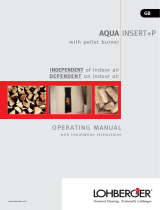
4
1 General information
1.1 Foreword
Dear System Owner, you have made a good
selection in the PYROMAT ECO. In conjunction
with a heat storage unit, it will provide you with all
the advantages of a modern, economically efficient
heating system. It will provide you with all the
advantages of a modern, economically efficient
heating system. Fully developed technology in
combination with a sturdy design guarantee a high
degree of operational reliability and long service
life.
These Operating and Maintenance Instructions
contain important information for the intended use,
correct operation and proper maintenance of the
PYROMAT ECO.
Non-compliance with the Operating and Main-
tenance Instructions will result in loss of the
guarantee.
If you still need any further information after study-
ing the Operating and Maintenance Instructions:
The Assembly and Installation Instructions contain
important information about:
- Standards and regulations,
- Structural surroundings of the burner
- Transport & assembly
- Water installation and electrical installation,
- Fire protection,
- Starting up,
as well as an appendix with diagrams of connec-
tions and dimensions as well as the complete tech-
nical specifications.
Our sales and services offices will be glad to pro-
vide you with any further information. Their ad-
dresses can be found on the reverse side of these
Operating and Maintenance Instructions.
1.2 Latest developments in the technology
The Operating and Maintenance Instructions are in
keeping with the PYROMAT ECO at the time it is
delivered. In the interest of our customers, we re-
serve the right to make, without any notification re-
quirement, the following changes resulting from
further technology developments.
1.3 Intended use
The intended use of the PYROMAT ECO is for in-
cinerating wood fuels.
The intended use of the PYROMAT ECO is stipu-
lated:
- in the regulations of the Assembly and Installa-
tion Instructions
- by the limits of the technical specifications
- in the section, "Suitable and approved fuels"
- by the safety regulations in these Operating and
Maintenance Instructions.
Any other use of the PYROMAT ECO or use of it
going beyond this will be considered as unintended
use unless written approval by the manufacturer
has been obtained.
The following, among other things, will be consid-
ered as unintended use:
- Operation of the PYROMAT ECO by unqualified
personnel, without any training or knowledge of
the Operating and Maintenance Instructions.
- Disabling the safety or monitoring devices on the
PYROMAT ECO.
- Removal of any protective covers or cladding on
the PYROMAT ECO by unauthorised individuals.
- Making any conversions or alterations to the PY-
ROMAT ECO without approval by the manufac-
turer.
- Using spare parts or accessories from other
manufacturers without approval by the manufac-
turer.
The operating organisation will be liable for
any damage or accidents in case of any unin-
tended use.
1.4 Technical specs
The following important limits apply to the PYRO-
MAT ECO heating boiler:
- Max. operating pressure allowed: 3.0 bar
- Max. boiler temperature allowed: 100°C
- Min. return temperature: 65°C
The complete technical specifications listed in the
appendix of the Assembly and Installation Instruc-
tions.
1.5 Documented information
The Operating Instructions contain the information
required according to the EC Directive on Machin-
ery 98/37/EEC, Appendix 1, Number 1.7.4.
Issue: 2007-08_English
Prepared by: KabW/SclM
1.6 CE-Symbol
The PYROMAT ECO is delivered with a CE-
symbol on its type plate an EC attestation of con-
formity in accordance with II A or the EC Directive
on Machinery 98/37/EEC.
If the PYROMAT ECO is altered by equipment
from other manufacturers being added, or the
safety equipment or control system are combined
with a different system and/or integrated into an
overriding system (building control system), then in
the European Union a new attestation of confor-
mity has to be issued before it is put on the market.

























